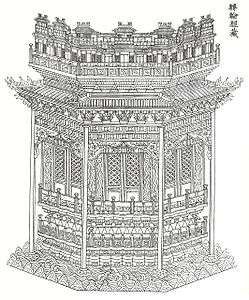Torah ark

The ark in a synagogue (also called the Torah ark or holy ark) is generally a receptacle, or ornamental closet, which contains each synagogue's Torah scrolls (Sifrei Torah in Hebrew).[1] Most arks feature a parokhet (curtain) placed either outside the doors of the ark (Ashkenazi and Mizrachi custom) or inside the doors of the ark (Spanish and Portuguese and Moroccan Sephardi custom). The ark is known in Hebrew as the aron kodesh ("holy ark") by the Ashkenazim and as the hekhál ("holy place") among most Sefardim.
Origin of the names
Aron Kodesh comes from Hebrew אָרוֹן קׄדֶש ʼārōn qōdeš (i.e. aron kodesh), Holy Ark. This name is a reference to the ’ārōn haqqōdeš, the Hebrew name for the Ark of the Covenant which was stored in the Holy of Holies in the inner sanctuary of both the ancient Tabernacle and the Temple in Jerusalem. Similarly, Hekhál, also written hechal, echal or heichal — and sometimes also Echal Kodesh (mainly among Balkan Sephardim) comes from Hebrew הֵיכָל [hēkhāl] ‘palace’, was used in the same time period to refer to the inner sanctuary. The hekhal contained the Menorah, Altar of Incense, and Table of the Showbread.
Placement
The ark is often placed on the wall of the sanctuary which is facing Jerusalem, however it is sometimes placed on the north wall or another wall for architectural reasons. In those cases where the ark does not show the direction to Jerusalem, traditional Judaism instructs the worshiper to face the true direction towards Jerusalem in prayers such as the Amidah.
In some ancient synagogues, such as the fifth-century synagogue in Susia, the Torah scroll was not placed inside the synagogue at all, but in a room adjacent to it, signifying that the sacredness of the synagogue does not come from the ark but from its being a house of prayer. The Torah was brought into the synagogue for reading purposes.
Gallery
 Beth Jakov synagogue in Macedonia
Beth Jakov synagogue in Macedonia
 Cedar, Jerusalem stone, and bronze Torah ark for Lincoln Square Synagogue, New York City (2013), by the artist David Ascalon.
Cedar, Jerusalem stone, and bronze Torah ark for Lincoln Square Synagogue, New York City (2013), by the artist David Ascalon.

 Ark based on a Chinese Buddhist design used by the Kaifeng Jews of China
Ark based on a Chinese Buddhist design used by the Kaifeng Jews of China

 Abuhav synagogue, Israel
Abuhav synagogue, Israel
See also
References
- ↑ Wischnitzer, Rachel, and Bezalel Narkiss (2007). "Ark." Encyclopaedia Judaica. 2nd ed. Vol. 2. Detroit: Macmillan Reference USA, 2007. p. 463-464.
External links
| Wikimedia Commons has media related to Torah_arks. |

